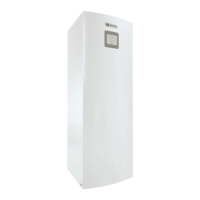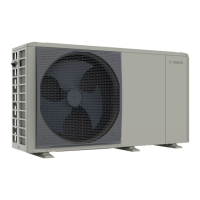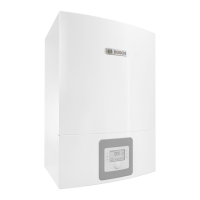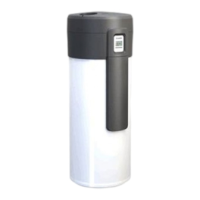Installation
13
Compress 7001i AW – 6721835318 (2021/09)
5.5.2 Water connecting pipe
NOTICE
Damage due to risk of frost!
If the condensate freezes and cannot be routed away from the heat
pump, the evaporator may be damaged.
▶ Always install pipe trace heating if ice is likely to form in the
condensate hose.
Remove condensate via a frost-free drain of the heat pump, possibly
equipped with pipe trace heating. The drain must slope sufficiently to
prevent water from accumulating in the pipe.
The condensate can be routed to either a gravel bed, a stone box or into
a rainwater gully.
▶ Route 32 mm plastic pipe from the condensate connection to a drain.
▶ Connection of pipe trace heating Chapter 7.1.
Fig. 17 Condensate tube connections, valid for all sizes
[1] Condensate line in rainwater gully
[2] Condensate line in gravel bed/stone box
[3] Connection for condensate tube
5.5.3 Connection of heat pump to the indoor unit
NOTICE
Material damage due to excessively high starting torque!
If connections are tightened too tightly, the heat exchanger may be
damaged.
▶ When installing the connection, the tightening torque should be no
more than 150 Nm.
Short pipe runs outdoors reduce heat losses. Use of pre-insulated pipes
is recommended.
▶ Use pipes in accordance with Chapter 5.5.1.
▶ Connect flow to the indoor unit at the heat transfer medium outlet of
the heat pump ( [1], Fig. 18).
▶ Connect return from the indoor unit at the heat transfer medium inlet
of the heat pump ( [2], Fig. 18).
▶ Tighten connections of the heat transfer medium pipes with a
starting torque of 120 Nm. Direct the force downwards ( Fig. 18)
to avoid lateral loading of the condenser.
If the connection does not seal properly, the joint can be tightened
with a starting torque of up to 150 Nm. If the connection is still not
tight, this indicates that the gasket or connected pipe is damaged.
Fig. 18 Connections of heat carrying medium pipes, valid for all sizes
[1] Heat transfer medium outlet (to the indoor unit) DN25
[2] Heat transfer medium inlet (from the indoor unit) DN25
5.5.4 Electrical connection
NOTICE
Malfunction due to faults!
High-voltage lines (230/400 V) in the vicinity of communication lines
can cause the heat pump to malfunction.
▶ Route sensor cable, EMS-BUS cable and shielded CAN-BUS cable
separately to power cables. Maintain a minimum distance of
100 mm. The BUS cable can be routed together with sensor cables.
The unit's electrical connection must be able to be disconnected safely.
▶ Install a separate safety switch that disconnects all power to the heat
pump if it is not supplied via the indoor unit. For a separate power
supply, a safety switch is required for each supply.
▶ Select the appropriate conductor cross-sections and cable types for
the respective fuse protection and routing method.
▶ Connect the heat pump according to the wiring diagram. No more
users can be connected.
▶ Install a separate residual current device according to applicable
standards in each country. We recommend a type B residual current
device.
▶ When changing the PCB, note the colour coding.
1
2
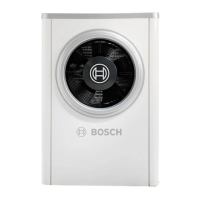
